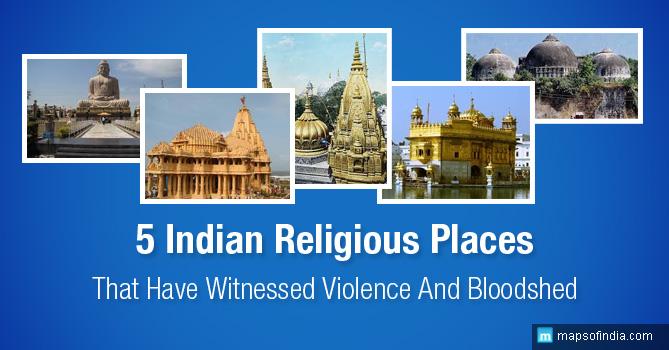Rock carving was of one the main art forms in ancient India, as you will find this done on almost every ancient temple. Mahabalipuram, also known as Mamallapuram is a wonderful tourist spot in India that is popular for its rock carved monuments and sculptured temples.
Mahabalipuram town is located at a distance of 58 Km from Chennai in the Kanchipuram district, Tamil Nadu. The town flourished as a major port during Pallava Dynasty in the 7th century. Mahabalipuram was also known by the nickname “the Land of Seven Pagodas” given by a European sailor who came to the place after seeing seven stupas of Hindu temples. Monolithic and rock cut monuments of this town clearly display the earliest form of the Dravadian architecture. The art is represented by monolithic chariots, sculptured temples, cave temples etc. Most of the monuments in Mahabalipuram represent Pallava art. Some of the sculptures found in the town have been displayed in the museum located in the town itself. Stone carving is such an important part of Mahabalipuram that there is an architectural school in the town where stone carving and history of sculpture is taught.
In 1st century AD, Mahabalipuram was the seaport and it was established as a town in 7th century by the Pallava kings. Mahabalipuram got its name after the name of the King Mamalla that means a great warrior. It was only during 7th century that rock-cut architecture in south India started to develop.
After 9th century, with the defeat of Pallava in the hands of the Cholas, importance of Mahabalipuram started to diminish and slowly the town was deserted. The monuments of Mahabalipuram were rediscovered in the 19th century and from then onwards it became a popular tourist spot. In 1984, Mahabalipuram became a UNESCO World Heritage site.
The five rathas, the Descent of the Ganges, the rock-cut decorated caves like Mahishasuramardini are what Mamalla is characterised by. Structural temples took the place of monolithic structures in 8th century and on these lines the Shore Temple was constructed in Mahabalipuram. The monuments at Mahabalipuram can be divided into rathas (includes Panch Rathas), cave temples (which include Varaha Cave Temple, Krishna Cave Temple, Mahishasuramardini mandapa, Panchapandava Cave Temple), structural temples (which include the Shore Temple and the Olakkannesvara Temple) and bas-reliefs (which includes the Descent of the Ganges).
The Pancha Rathas (The Five Rathas)
The Pancha Rathas also known as Pandava Rathas, represent the monolithic rock cut architecture of India. It consists of five structures –the Dharmaraja Ratha, the Bhima Ratha, the Arjuna Ratha, the Nakula and Sahadeva Ratha and the Draupadi Ratha. Though the name is similar, but these structures bear no connection with the Mahabharata characters. All of these structures are carved from a single rock stone but in different ways. Apart from these rathas, one ratha was constructed in late 7th century known as Ganesha Ratha. Each of these monuments is carved in the form of ratha or chariot from a single granite rock and seen above the sandy beach. As all of these structures are incomplete so not worshiped like other temples.
The Shore Temple
One of the best known temples of Mahabalipuram is the Shore Temple that indeed consists of three temples – the Rajasimhesvara, the Kshatriyasimhesvara and Nripatisimha Pallava Vishnugriha. The Shore temple is located just on the shore and built about 1300 years ago. Sea winds are continuously eroding most of the carving and sculptures of this beautiful Shore Temple.
Arjuna’s Penance – The Descent of the Ganges
Arjuna’s Penance is located south to the Balancing Rock (another popular tourist spot at Mahabalipuram) is an open-air relief that is carved out of two monolithic rock boulders. The Descent of the Ganges is located on the Coromandel Coast, Bay of Bengal. This depicts the story of the holy River Ganges and its descent from heaven to Earth. It looks like a canvas that is unique and not found anywhere else in India. Many life size figures are carved on the rock boulders of pink granite. Before the carved walls, there is a figure of monkeys taking care of each other and nursing a baby.
Varaha Cave Temple
Varaha Cave Temple is carved in the rock. Because of location most of the carvings are well protected in this temple.
Mandapas
Mandapas are the temples that are in the form of covered bas-reliefs. These are the rock cut caves that were later on carved with the help of chisel and iron mallet. In Mahabalipuram there are eleven such caves. These are the examples of astonishing bas-reliefs especially of Goddess Durga who killed Mahishasura. Most of the caves of Pallava period are incomplete.
Balancing Rock of Mahabalipuram
Known as Krishna’s Butter Ball, this amazing rock at Mahabalipuram rests on a narrow rock base. The stone ball is extremely huge. This balancing rock attracts many visitors.
Conservation of monuments
To protect these masterpieces of art and to beautify Mahabalipuram, the project “Integrated Development of Mamallapuram” was initiated in 2003. The clean-up work included laying lawns, pathways, building parks, fencing and removal of illegal encroachments.
Mahabalipuram is indeed a historic town and represents art form of the Pallava Dynasty.
!@#$%
For more information visit :
Mahabalipura




